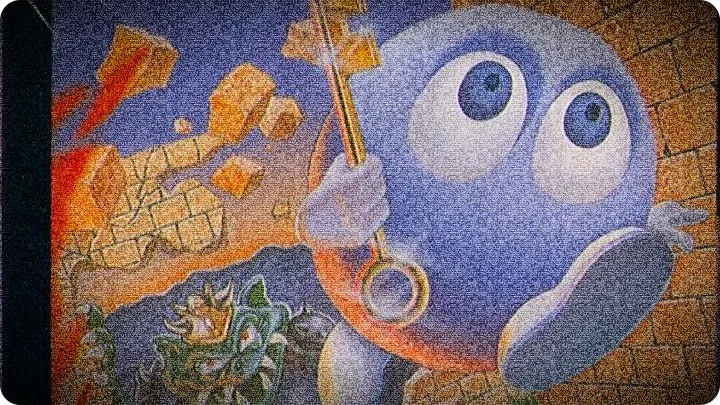(April 1989. The CRT hums. The cartridge snaps into place and the title screen blinks. Two friends lean in.)
 There is a small, interesting bit of trivia before we dive in—HAL Laboratory developed this one. They are the same Osaka team that has been quietly crafting clever, tight design for years; later they’ll be famous for Kirby, but right now they’re polishing puzzle logic down to a science. It shows.
There is a small, interesting bit of trivia before we dive in—HAL Laboratory developed this one. They are the same Osaka team that has been quietly crafting clever, tight design for years; later they’ll be famous for Kirby, but right now they’re polishing puzzle logic down to a science. It shows.
 Right now? We are in room one and the music is already pleasantly catchy. The premise is charmingly simple: Princess Lala is kidnapped by the Evil Demons of the Empire and our hero Lolo—round, determined and oddly expressive—must collect hearts, then the treasure chest, then the exit in each single-screen room. There are 50 rooms in total, so this is a long, steady train of brainteasers.
Right now? We are in room one and the music is already pleasantly catchy. The premise is charmingly simple: Princess Lala is kidnapped by the Evil Demons of the Empire and our hero Lolo—round, determined and oddly expressive—must collect hearts, then the treasure chest, then the exit in each single-screen room. There are 50 rooms in total, so this is a long, steady train of brainteasers.
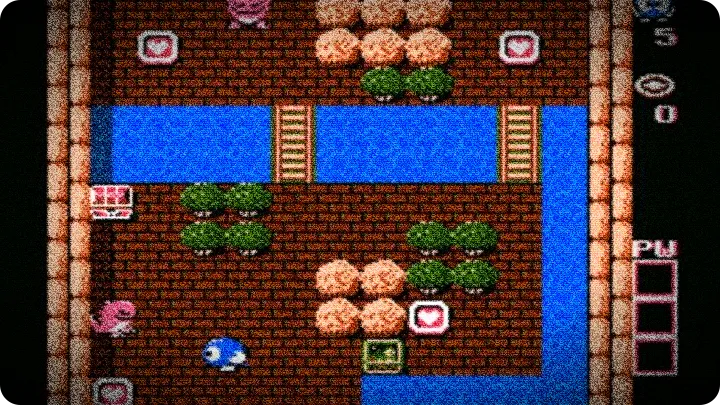
Gameplay Highlights
 Playing this live, the thing that stands out is how crisp the core mechanics are. Lolo can push blocks, shoot enemies once he earns that power-up, and turn nasties into eggs to shove around. The enemy types are varied and the rules for each are strict, which makes the puzzles feel fair instead of random. Every piece on screen is part of the logic.
Playing this live, the thing that stands out is how crisp the core mechanics are. Lolo can push blocks, shoot enemies once he earns that power-up, and turn nasties into eggs to shove around. The enemy types are varied and the rules for each are strict, which makes the puzzles feel fair instead of random. Every piece on screen is part of the logic.
 There is an admirable economy to the design: stationary blockers, line-of-fire shooters, patrollers that sleep when you touch them, and enemies that chase when hearts are gone. HAL layers new behaviors gradually so the difficulty curve feels natural. When a room finally clicks, the satisfaction is old-school and pure.
There is an admirable economy to the design: stationary blockers, line-of-fire shooters, patrollers that sleep when you touch them, and enemies that chase when hearts are gone. HAL layers new behaviors gradually so the difficulty curve feels natural. When a room finally clicks, the satisfaction is old-school and pure.
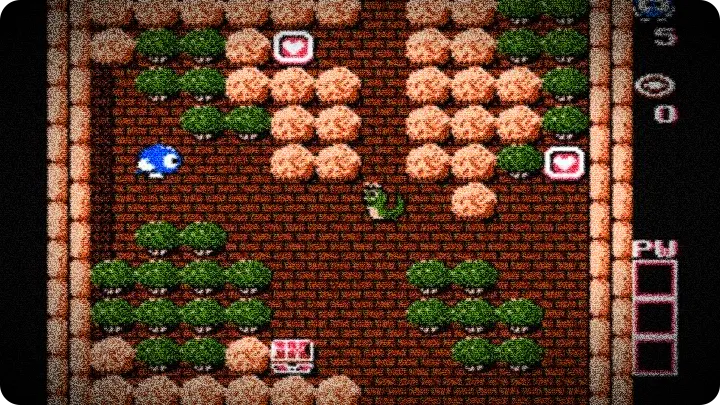
Hot Tips (from two controllers arguing)
- Plan before you move: Many rooms punish thoughtless pushes. If you push a block into a corner, rewind—oh wait, no rewind. Start rooms visually before committing.
- Use eggs as tools: Turning an enemy into an egg makes it movable. You can use eggs to block shooters or to bridge gaps. Treat eggs like temporary blocks, not just obstacles.
- Trigger timing matters: Some enemies are quiet until all hearts are taken; collecting hearts in the wrong order can make a room impossible. Lure and bait where necessary.
- Power-ups are precious: The ability to shoot or break a block often solves the puzzle outright. Save those power-ups for the intended place rather than wasting them early.
- Experiment—many rooms have multiple solutions: If one plan fails, the room often nudges you to try another path rather than trapping you irreparably.
 Also, if you’re the sort to blow on cartridges—do it for the ritual, not the results. The NES gods enjoy ceremony in April of 1989.
Also, if you’re the sort to blow on cartridges—do it for the ritual, not the results. The NES gods enjoy ceremony in April of 1989.
Memorable Moments & Anecdotes

 There is one room, roughly mid-pack, where a shooter guards a narrow corridor and a patroller sleeps where it touches you. We stood over the controller, heart rates matching the soundtrack, executing pixel-perfect pushes to slide eggs into place and block lines of fire. When the chest finally popped and the exit connected, it felt like solving an elaborate mechanical lock. Those moments are frequent: rooms that are tiny mechanical puzzles with satisfying domino effects.
There is one room, roughly mid-pack, where a shooter guards a narrow corridor and a patroller sleeps where it touches you. We stood over the controller, heart rates matching the soundtrack, executing pixel-perfect pushes to slide eggs into place and block lines of fire. When the chest finally popped and the exit connected, it felt like solving an elaborate mechanical lock. Those moments are frequent: rooms that are tiny mechanical puzzles with satisfying domino effects.
 Another memorable moment is the occasional “aha” where a block you thought useless becomes the pivot for the entire solution. HAL’s level design rewards looking at what cannot be moved and asking, “How can I use this immovable thing?” There is artistry in restraint here.
Another memorable moment is the occasional “aha” where a block you thought useless becomes the pivot for the entire solution. HAL’s level design rewards looking at what cannot be moved and asking, “How can I use this immovable thing?” There is artistry in restraint here.
 We should talk about the final boss. After fifty rooms the castle finally presents a sequence where timing and resource management are tested simultaneously. The final encounter is less about brute force and more about pattern recognition: you must stall, manipulate enemies into harmless states, and use the shooting power-up at precisely the right instant. When Lolo at last reaches Lala, the screen feels earned—no grand fireworks, but a satisfying culmination of the mechanics you have been mastering room after room.
We should talk about the final boss. After fifty rooms the castle finally presents a sequence where timing and resource management are tested simultaneously. The final encounter is less about brute force and more about pattern recognition: you must stall, manipulate enemies into harmless states, and use the shooting power-up at precisely the right instant. When Lolo at last reaches Lala, the screen feels earned—no grand fireworks, but a satisfying culmination of the mechanics you have been mastering room after room.
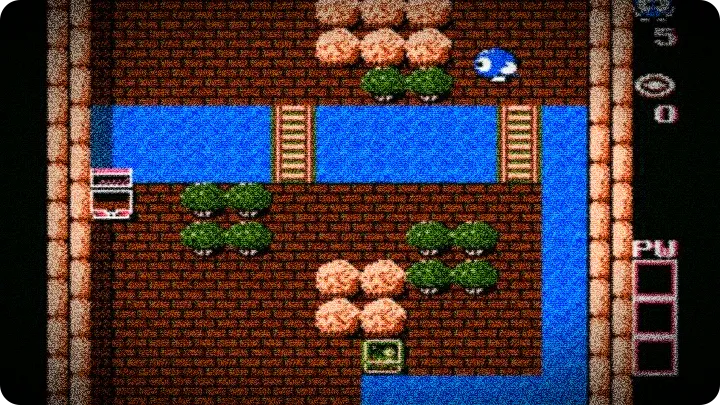
 The ending is modest but fitting. There is no cinematic flourish, simply the relief of having used every trick in the toolkit to topple the Empire’s little puzzles. It is quietly triumphant.
The ending is modest but fitting. There is no cinematic flourish, simply the relief of having used every trick in the toolkit to topple the Empire’s little puzzles. It is quietly triumphant.
 Now for candid notes. The presentation is clean but austere. The sprite work is cute, but some rooms begin to feel visually repetitive after many hours. Also, the difficulty curve spikes occasionally; a few rooms rely on near-perfect execution or obscure ordering, which can feel like gatekeeping rather than puzzle design.
Now for candid notes. The presentation is clean but austere. The sprite work is cute, but some rooms begin to feel visually repetitive after many hours. Also, the difficulty curve spikes occasionally; a few rooms rely on near-perfect execution or obscure ordering, which can feel like gatekeeping rather than puzzle design.
 I agree. For players who prize fairness and design clarity, Lolo is a delight most of the time. For those who prefer constant variety in visuals or more forgiving checkpoints, it can be occasionally unforgiving. Still, the core puzzles are intelligent and the game teaches you through elegant escalation.
I agree. For players who prize fairness and design clarity, Lolo is a delight most of the time. For those who prefer constant variety in visuals or more forgiving checkpoints, it can be occasionally unforgiving. Still, the core puzzles are intelligent and the game teaches you through elegant escalation.
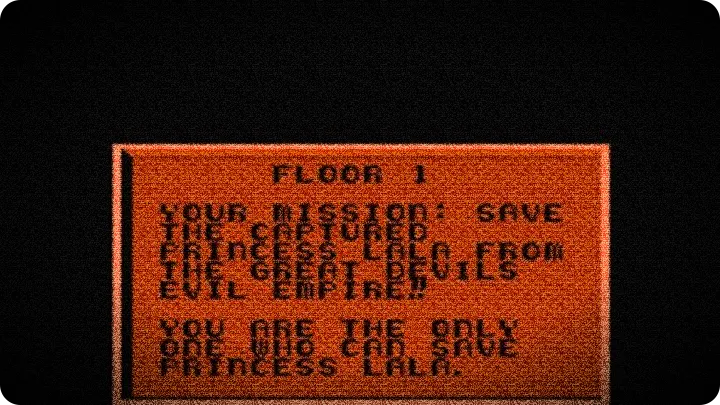
 Overall feeling while playing right now: it is a sturdy, thoughtful puzzle game. We will say plainly—we give it a B. It is not perfect, but it is consistently clever, with many rooms that are small masterpieces of logic and a final confrontation that rewards careful play rather than button-mashing.
Overall feeling while playing right now: it is a sturdy, thoughtful puzzle game. We will say plainly—we give it a B. It is not perfect, but it is consistently clever, with many rooms that are small masterpieces of logic and a final confrontation that rewards careful play rather than button-mashing.
 For anyone with a patient mind and a love for single-screen puzzles, Adventures of Lolo is worth seeing through. Dust off that controller, lean into the CRT glow, and prepare to think in tiny, precise increments.
For anyone with a patient mind and a love for single-screen puzzles, Adventures of Lolo is worth seeing through. Dust off that controller, lean into the CRT glow, and prepare to think in tiny, precise increments.
more info and data about Adventures of Lolo provided by mobyGames.com

